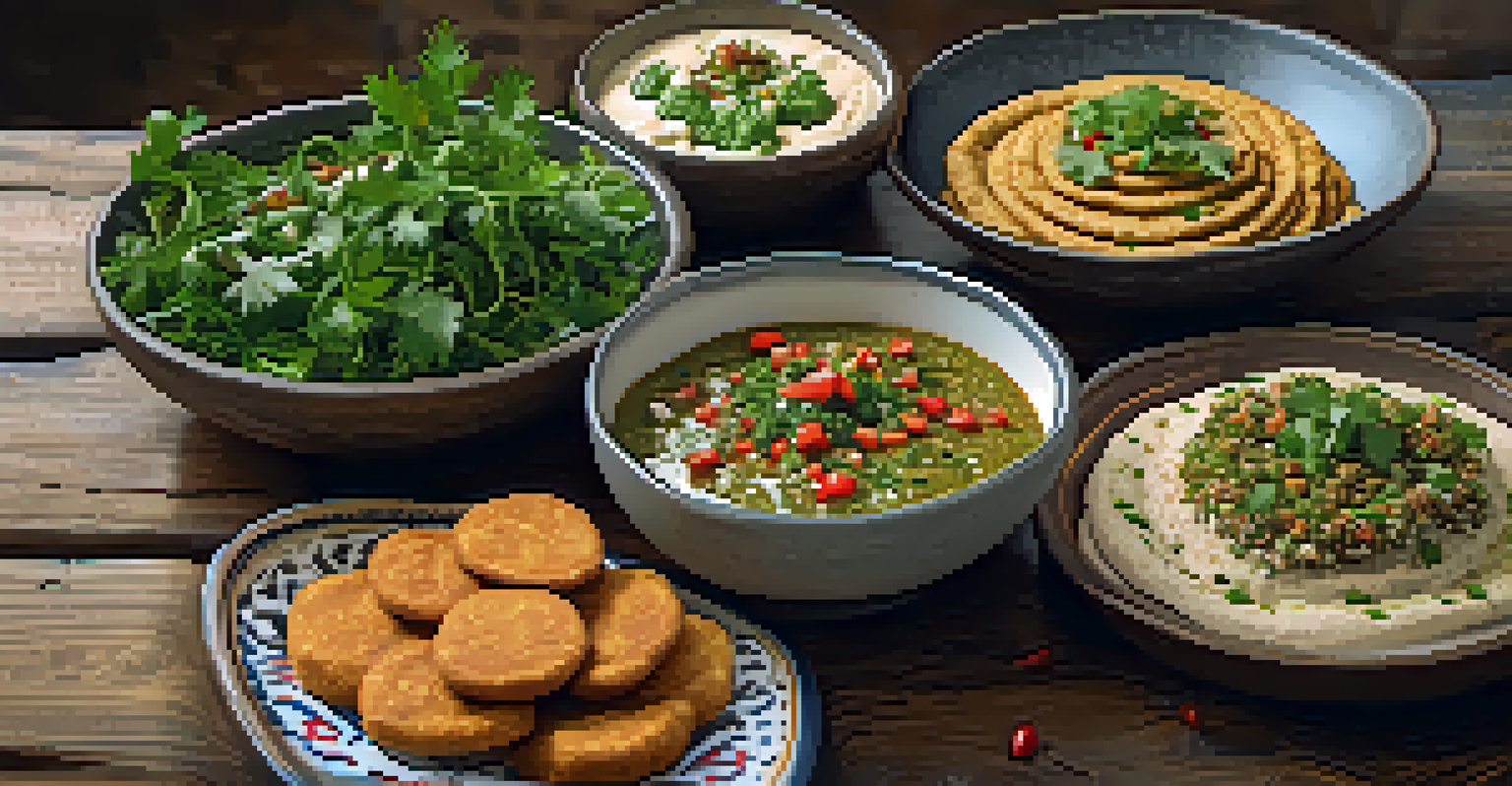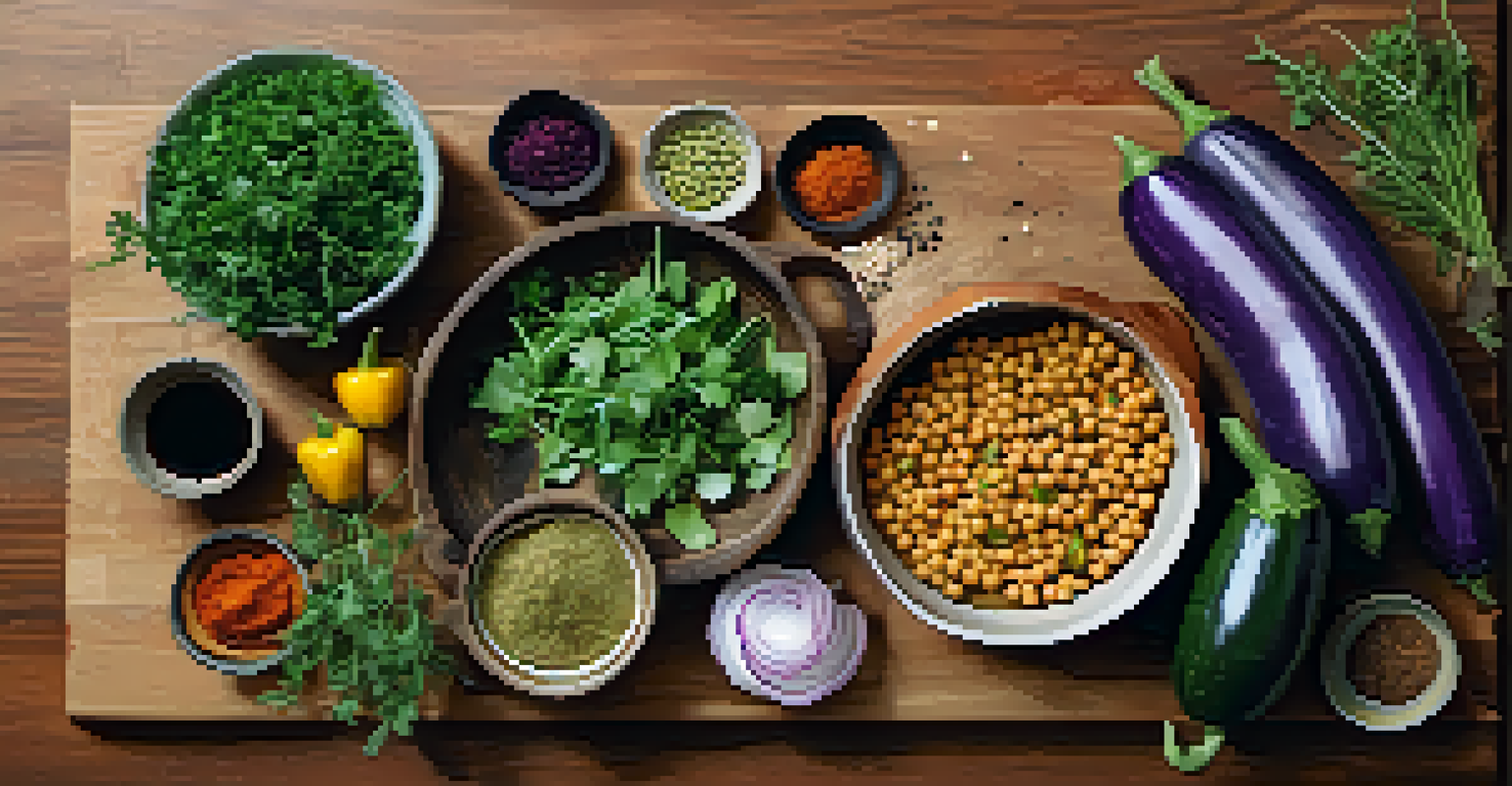Middle Eastern Vegetarian Cuisine: Tastes of Tradition

Introduction to Middle Eastern Vegetarian Cuisine
Middle Eastern vegetarian cuisine is a vibrant tapestry of flavors, colors, and textures. Rich in history and culture, it reflects the diverse agricultural bounty of the region, where fresh vegetables, legumes, and grains reign supreme. This cuisine not only caters to vegetarians but also showcases the traditional culinary practices of the Middle East, where meat was often a luxury.
Food is a universal language, and through it, we can share our cultures and traditions.
From the bustling markets of Istanbul to the serene landscapes of Lebanon, the ingredients tell a story of sustainability and resourcefulness. Staples like chickpeas, lentils, and fresh herbs are not just delicious; they are packed with nutrients and play a vital role in the local diet. The emphasis on plant-based dishes highlights a lifestyle that values health and harmony with nature.
In this article, we will dive into popular dishes, explore regional variations, and celebrate the traditions that make Middle Eastern vegetarian cuisine so special. Get ready to tantalize your taste buds and discover recipes that have been passed down through generations.
Key Ingredients in Middle Eastern Vegetarian Dishes
The heart of Middle Eastern vegetarian cuisine lies in its key ingredients. Staples like olive oil, garlic, and lemon juice are used to enhance the natural flavors of vegetables and grains. Spices such as cumin, coriander, and sumac add depth and complexity, transforming simple dishes into flavorful experiences.

Legumes play a starring role in many traditional recipes, providing protein and fiber. Dishes like falafel and hummus showcase the versatility of chickpeas, while lentil soup offers a hearty, comforting option for any meal. Fresh herbs like parsley, mint, and dill not only add color but also brighten up flavors, making every bite a refreshing delight.
Diverse Flavors of Middle Eastern Cuisine
Middle Eastern vegetarian cuisine is a colorful blend of fresh ingredients and spices, reflecting the region's rich cultural heritage.
Moreover, vegetables like eggplant, zucchini, and bell peppers are often featured in various forms, whether grilled, roasted, or stewed. The emphasis on seasonal produce ensures that the dishes are not only tasty but also aligned with nature's rhythms, promoting sustainability.
Popular Middle Eastern Vegetarian Dishes to Try
One of the most beloved vegetarian dishes is falafel, crispy chickpea balls that are perfect in wraps or on their own. Served with tahini sauce or in a salad, falafel is a staple street food across the region. Another favorite is baba ganoush, a smoky eggplant dip that pairs beautifully with pita bread.
The spices of life are the flavors that enrich our days.
Tabbouleh is another must-try, a refreshing salad made predominantly of parsley, tomatoes, bulgur, and a splash of lemon juice. Its bright flavors and crunchy texture make it a delightful accompaniment to any meal. And let's not forget about stuffed grape leaves, known as dolmas, which are filled with rice, herbs, and occasionally nuts, offering a delightful bite-sized treat.
These dishes not only showcase the rich flavors of the region but also the creativity and resourcefulness of Middle Eastern cooks. Each recipe carries its own story, connecting you to the traditions and cultures of the people who have enjoyed them for centuries.
Regional Variations in Vegetarian Cuisine
Middle Eastern vegetarian cuisine is incredibly diverse, with each region offering its unique spin on traditional dishes. For instance, Levantine cuisine, which encompasses countries like Lebanon and Syria, is known for its fresh salads and flavorful dips. In contrast, North African influences bring spices like saffron and harissa, adding a whole new dimension to vegetarian dishes.
In Turkey, you'll find vegetarian kebabs made with grilled vegetables, while in Egypt, koshari—a hearty mix of rice, lentils, and pasta topped with tomato sauce—is a popular comfort food. Each variation reflects local ingredients and cultural influences, making the culinary landscape rich and varied.
Health Benefits of Plant-Based Meals
The reliance on vegetables, legumes, and whole grains in Middle Eastern vegetarian dishes promotes numerous health benefits and overall wellness.
This regional diversity allows for endless exploration and adaptation of recipes. No matter where you are in the Middle East, there’s always a new dish to discover that speaks to the local traditions and flavors.
The Role of Spices in Flavoring Vegetarian Meals
Spices are the magic that brings Middle Eastern vegetarian dishes to life. Cumin, coriander, and allspice are just a few of the essentials that infuse meals with warmth and depth. The art of spice blending is crucial, with each cook often having their unique combination that tells their culinary story.
For instance, za'atar—a blend of thyme, sesame seeds, and sumac—adds a tangy, herbal flavor that can elevate simple dishes like roasted vegetables or labneh. Similarly, a sprinkle of cinnamon can transform a savory stew into something unexpectedly delightful, showcasing the versatility of spices.
Understanding how to use these spices not only enhances flavor but also connects you to the traditions of the region. Experimenting with different spices can lead to delicious discoveries in your own kitchen, making every meal an adventure in taste.
Health Benefits of Middle Eastern Vegetarian Foods
Middle Eastern vegetarian cuisine is not only delicious but also incredibly healthy. The reliance on fresh vegetables, legumes, and whole grains means that meals are packed with vitamins, minerals, and fiber. This plant-based diet has been linked to numerous health benefits, including reduced risk of chronic diseases.
For example, high-fiber foods like lentils and chickpeas can aid in digestion and promote heart health. Additionally, the abundance of antioxidants found in spices and fresh herbs can help combat inflammation and support overall wellness. With such a focus on wholesome ingredients, it's easy to see why this cuisine is celebrated for its healthfulness.
Easy Ways to Bring Flavors Home
Incorporating Middle Eastern flavors into your cooking is simple and enjoyable, starting with essential pantry staples and classic recipes.
Embracing Middle Eastern vegetarian dishes can be a step towards a healthier lifestyle. Not only can you enjoy the vibrant flavors, but you can also feel good about nourishing your body with wholesome, plant-based foods.
How to Incorporate Middle Eastern Flavors at Home
Bringing the flavors of Middle Eastern vegetarian cuisine into your home kitchen is an exciting adventure. Start by stocking your pantry with essential ingredients like olive oil, tahini, and a variety of spices. Having these staples on hand makes it easy to whip up delicious dishes any day of the week.
Consider trying your hand at classic recipes like tabbouleh or hummus, which are simple yet bursting with flavor. As you gain confidence, experiment with more complex dishes, such as stuffed peppers or a hearty lentil stew. The beauty of this cuisine lies in its adaptability; you can easily modify recipes to suit your taste preferences or dietary needs.

Lastly, don't forget to share the experience with family and friends. Cooking can be a wonderful way to connect with others, and enjoying a meal together allows you to celebrate the rich culinary traditions of the Middle East.